Revolutionary Tennis |
||
Tennis Instruction That Makes Sense |
||
Step 5 Control Your Power Absolute Strength Posture Final Position and Contact A Question of Trust Conventional tennis emphasizes what you look like after you've hit the ball, that is, follow-through up high, hips/shoulders face the net. What your body looks like at contact is everything, not what it looks like after you've hit. The contact is the climax of events in tennis, not ball placement. Without quality contact the ball won't go where and how you want it to. AT CONTACT YOU CAN LOSE YOUR FOUNDATION At contact it's not just enough to hit the ball on time, you have to avoid losing your foundation in the process. You have to avoid jumping, twisting, rotating, leaning, moving back, or projecting your body weight somewhere else other than into the tennis ball. Power from the body (weight shift) is projected into the ball at contact, it isn't projected along the flight line of the ball toward the opponent. But, you ask, isn't moving into the ball enough? It's most of it, but you can still lose your foundation here as well. A tennis ball is never "right there" waiting to be hit. At contact it still angles away from you, and when you hit it, it hits the racket back in an equal but opposite direction. When you shift your weight prior to contact, you can rock back equally in an opposite direction. And the swing's angular momentum pulls you away from the ball at contact, that is it pulls you away from the direction in which you've been moving your body weight (into the ball). To get the results you want, you need to avoid being pushed around during contact by the forces of physics. You're not going to win that battle, but you can deny it as best you can. How? By structuring the body into a position of absolute strength. Your body is in a position of absolute strength when it is optimally balanced for the task at hand and maintains that balance during the task. If you pick up a box and lean side to side or bend over, you lose strength. While you can be balanced when on your back, squatting, or sitting in a chair, you are strongest with your arms when you're standing. ABSOLUTE STRENGTH = BALANCE BALANCE = MOVEMENT + POSTURE + FINAL POSITION A body that is balanced physically is a body that is strong. The structure involved to project this strength was first developed for both dance and self-defense and can be seen today in ballet and the martial arts. I learned this structure when I voluntarily took some private ballet lessons to complement my therapy following arthroscopic knee surgery. The physical structure to balance is universal and can be applied to tennis more easily than for either golf or baseball. Yea for us, and we don't have to turn our feet out.
1) both your shoulder line and hip line remain parallel to the ground beneath them; 2) your torso is back, upright, shoulders back and relaxed; 3) your hips are thrust, or tucked under, in a forward position, tailbone pointing down. MOVEMENT & THE BODY CENTER There are all sorts of ways people walk. Watch the world go by on a street corner and you'll be entertained by the variety of styles. But there is an optimum way to move when athletic activity is involved. The most efficient way to move any object is to move the center of the object. The center of the human body is the groin area, and, to be efficient, the body's center should move you, or pull you, forward. To do this, the hips sway into the forward position and the tailbone points down. Too often your torso leans over first and then you move, and/or your rear end is cocked back.
Move first from your body center, 5AA. Don't push off from your feet or lose your balance to force yourself to move. A dancer's grace and balance comes from moving his/her center, and a dancer jumps very high not because s/he pushes his/herself up off the floor with the feet (5B, left arrow), but because the body center both lifts the body beneath it and pushes the body above it (5B, right arrows ). The torso and head are back when the body center moves first. The upper body appears to float above the lower body, with the lower body doing the most work. Unencumbered by having to counter any imbalance, the lower body and midsection can then provide maximum support to the arms. The end result is the strongest foundation possible when hitting or striking. Power. The body's center and its usage is the end-all and be-all of any physical movement or endeavor. Balance and power flow from the center, are sourced from the center, and are available to you when the fewest forces act against the center. Rotating the body's center makes it harder to maintain balance and source your power, unlike when using linear momentum to shift your body weight. POSTURE
Commonly, there's a horizontal understanding to balance, as when you extend your arms out away from you (horizontally) to keep from falling over. But what's really going on is you're trying to achieve vertical balance during your routine, achieving balance from between your feet up through your groin and torso and into your head, as in when you stand up straight, or balance a book on your head while you walk. I've drawn a line on photo 5D to represent this vertical balance.
Leaning into the ball not only means you're losing strength from the body, but your timing also suffers because your vision is impaired. Vision, and how it and only it directly relates to timing, is in Step 7. Another standard concept is to get both hand and racket face down together on a low ball. This means you bend over at the waist, losing balance, or, if you don't bend over, your shoulder line and hip line no longer remain parallel to the ground, they tilt. Your stroke loses body support and leverage with this popular idea. A simpler way to hit a low ball will be introduced in a following Step. A popular idea that is valid is to bend the back knee more than the front knee prior to contact, but it's merely an offspring of keeping your tailbone down. With the tailbone down, by default your back leg bends more than the front. And you'll also find your shoulder line and hip line will be parallel to the court and your torso back. Remember, you can bend your back leg more yet still lean over, lean to the side, or tilt back and lose your balance. A simple review. Move from the center, hips and buttocks forward, tailbone down, shoulder/hip line parallel to the court, and stand up as you move to maintain vertical balance. The lower body does the work the upper body maintains form. The upper body floats above the lower body, and the torso, head, and shoulders are back, relaxed. FINAL POSITION & CONTACT
As you swing, the key to not losing your foundation is: THE BODY SHUTS DOWN
A tennis player's contact is very close to the body, the arms don't need to fully extend away from the body. More follows in Step 6. If you try to shift "more" by leaning or jumping into the ball you lose your balance and thus your strength. Pros jump and twist to get more "power" into the ball, but if they remained balanced and centered they could hit even harder. I know from experience it's hard to do because tennis is a quick game and swings are executed at breakneck speed. But since everything's relative, the same applies to you as for the pro: keep the body calm and under control during the swing, try not to rotate to empower the hit, and snap that racket into the ball. IT'S A QUESTION OF TRUST Remember lifting the heavy box? You might not understand all the dynamics involved, but you trust the technique. The same applies here. With your body well balanced and directed into the ball, and with your weight shifted properly (from the center), the arms can execute their task with the most possible speed and strength. The objective of any swing is to generate a large burst of energy over a small period of time and space and to do it without tearing the house down with it, so to speak. The examples I use are Muhammad Ali's "invisible" knockout punch over Sonny Liston, and Bruce Lee's two-inch punch (or however small in length it really was). Step 6 elaborates with the Ultimate Striking Theory. Trust the body's strength configuration and know its limits. Martial artists do, and boxers, and dancers, and a host of other disciplines. Tennis shouldn't be any different, it relies on, and uses, the body as well. Configure the body for maximum strength and the striking of the ball improves, no matter what your stroke is like. You might not be able to keep the ball in the court with this increased power, but later Steps involving the strokes will help you with that. Information on strokes is starting to creep in here. How the body works and how the strokes work are two separate and distinct areas. The body has its own direction, responsibility, and obligation, and the stroke has its own separate purpose. Each must act independent of the other. The body provides the power, the stroke provides control; the body shifts into the contact, the stroke sends the ball away from you (Step 6). When you begin to use your body correctly as a power source you will hit the ball out because your stroke has been compensating for a lack of body power. If you play twice a week, in less than 4 weeks your stroke will gladly give up its unnecessary power role to do what it needs to do, control the impact. The stroke automatically scales itself back, I've seen it all the time. Your instincts get the picture, that is if you move into the ball. Golfers and baseball batters would benefit if they also separated body rotation from their swing. Just as for tennis, a golfer/batter's body momentum must be directed into the contact spot, and nowhere else, a task made more difficult when the body rotates. A golfer or batter should direct their angular momentum (rotation) only into the contact spot and let the stroke go towards the playing field. LET THE STROKES BEGIN The strokes now become the house that sits on top of your foundation. As with the walls and rooms of a house, no mater the design, the strokes follow their own structure regarding weight load and strength. Step 6 explains what is common to all tennis strokes, and later Steps will fill in the details.
|
||||
|
|
||||||||||||||||||||||||||||||||||||||||||||||||||||||||||||||
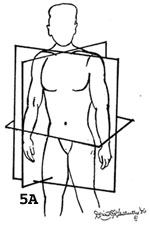 I define balance here as movement, posture, and final position. Diagram 5A (by Denise Gasaway) shows the three planes of the human body. What structures your body-as-strength the most is when:
I define balance here as movement, posture, and final position. Diagram 5A (by Denise Gasaway) shows the three planes of the human body. What structures your body-as-strength the most is when: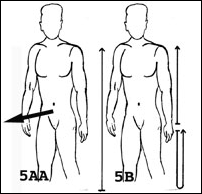
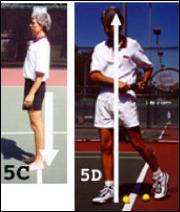 Good posture means you stand upright in your torso, head back, shoulders pulled back and relaxed down. Your hips are tucked under in the forward position so that your tailbone points down, 5C arrow, and your shoulder line and hip line are parallel to the ground below.
Good posture means you stand upright in your torso, head back, shoulders pulled back and relaxed down. Your hips are tucked under in the forward position so that your tailbone points down, 5C arrow, and your shoulder line and hip line are parallel to the ground below.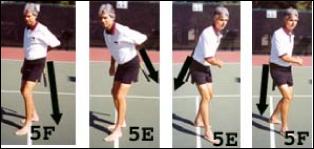 When the hips are cocked back you lose your balance and thus power. This posture that relates to the tailbone pointing out instead of down is common in all players, including the pros when they want to tag a forehand, and helps further explain a backhand's weakness. In photos 5E and 5F I'm holding my racket behind my back and using the arrows to illustrate where my tailbone is "pointing." In 5E the tailbone points out, which means I'm not strong because I'm not balanced, my hips are cocked back. In 5F my tailbone points down, it's in a normal position, and how I have power from the body available for my stroke.
When the hips are cocked back you lose your balance and thus power. This posture that relates to the tailbone pointing out instead of down is common in all players, including the pros when they want to tag a forehand, and helps further explain a backhand's weakness. In photos 5E and 5F I'm holding my racket behind my back and using the arrows to illustrate where my tailbone is "pointing." In 5E the tailbone points out, which means I'm not strong because I'm not balanced, my hips are cocked back. In 5F my tailbone points down, it's in a normal position, and how I have power from the body available for my stroke.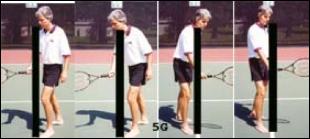 Good posture further means the torso doesn't lean over so that your head extends beyond the toes, as represented by the black line in the two inner photos in 5G. If you're familiar with lunges, you know the knee doesn't extend past the foot as you lunge, nor does it turn inward or outward. A similar alignment structure applies to the torso with respect to the lower body, the torso and head should not lean out past the feet (or backward), the two outer photos in 5G.
Good posture further means the torso doesn't lean over so that your head extends beyond the toes, as represented by the black line in the two inner photos in 5G. If you're familiar with lunges, you know the knee doesn't extend past the foot as you lunge, nor does it turn inward or outward. A similar alignment structure applies to the torso with respect to the lower body, the torso and head should not lean out past the feet (or backward), the two outer photos in 5G.
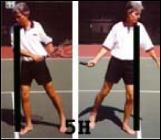 A popular idea in tennis teaching is to lean into the ball, 5H. This means your torso extends sideward beyond the width of the hips and out past the knee and foot, a clear indication of losing balance. 5HH shows vertical balance, not leaning sideward into the ball, no leaning over, tailbone down. Aggressive players will get down lower than I am in photo 5HH and bend their knees as necessary, but neither the front knee not the torso will extend past the toes, and the tailbone remains pointing down.
A popular idea in tennis teaching is to lean into the ball, 5H. This means your torso extends sideward beyond the width of the hips and out past the knee and foot, a clear indication of losing balance. 5HH shows vertical balance, not leaning sideward into the ball, no leaning over, tailbone down. Aggressive players will get down lower than I am in photo 5HH and bend their knees as necessary, but neither the front knee not the torso will extend past the toes, and the tailbone remains pointing down. Prior to contact you shift your weight and establish the final position, the end result of movement and posture. To shift your body weight, you shift the center of your weight, the groin area. Your body's center (of gravity) lowers before you hit the ball, and then you inject the weight into the ball on a straight line parallel to the ground, 5I. Aggressive players will lengthen their shift (and increase power) by lengthening their stride but neither the front knee not the torso will extend past the toes, and the tailbone points down.
Prior to contact you shift your weight and establish the final position, the end result of movement and posture. To shift your body weight, you shift the center of your weight, the groin area. Your body's center (of gravity) lowers before you hit the ball, and then you inject the weight into the ball on a straight line parallel to the ground, 5I. Aggressive players will lengthen their shift (and increase power) by lengthening their stride but neither the front knee not the torso will extend past the toes, and the tailbone points down.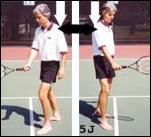 To help the swing accelerate and enjoy the most strength and support from the body, the body doesn't move. Except for the swinging arm, of course. Your front shoulder remains still up through contact, 5J, acting as a brake against the force of the stroke to accelerate it. Rotation, besides moving you away from the ball and being a complicated power source unnecessary for tennis, creates friction during the swing and slows it down.
To help the swing accelerate and enjoy the most strength and support from the body, the body doesn't move. Except for the swinging arm, of course. Your front shoulder remains still up through contact, 5J, acting as a brake against the force of the stroke to accelerate it. Rotation, besides moving you away from the ball and being a complicated power source unnecessary for tennis, creates friction during the swing and slows it down.